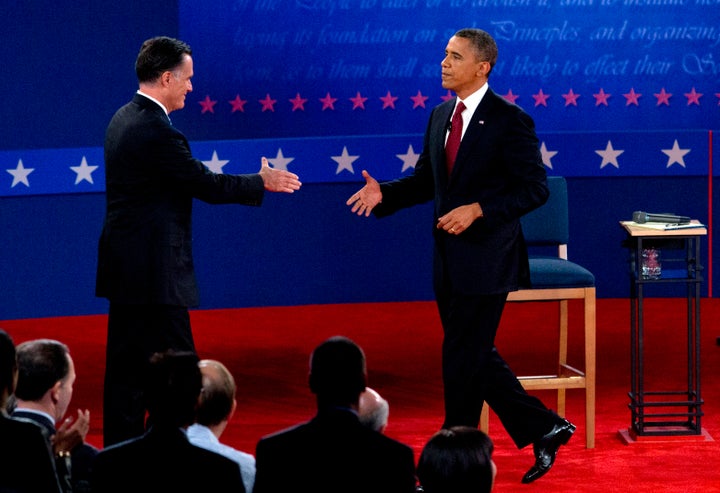
We glimpsed two starkly different visions of our energy future last night.
President Obama laid out a strategy to grow our domestic energy supplies, invest in efficiency and advance our use of wind, solar and other renewable sources of power.
Gov. Romney doubled down on his plan to bet our future on the fossil fuels of the past. "I will fight for oil, coal and natural gas," he vowed, before his case quickly fell apart.
Romney made it sound as if the president has pushed renewables at the expense of fossil fuels. The facts show otherwise.
U.S. oil production, at 6.2 million barrels a day, is up 24 percent since Obama took office, to the highest levels since the Clinton administration, according to September figures from the U.S. Energy Information Administration, the independent data collection and analysis arm of the U.S. Department of Energy.
Romney's fossil-fuels-first approach is nothing more than drill, baby, drill -- with a nice haircut.
In fact, we're drilling more oil wells in this country than at any time in three decades. We drilled 12,000 new oil wells in the first six months of this year. That's a new oil well every 20 minutes. We're on track to drill more than 24,000 new oil wells this year alone, 44 percent more than we drilled in 2008, the year Obama was elected.
Frankly, we think the drill rate is excessive, and we've said so. In particular, we're opposed to the Obama administration's decision to allow drilling in the Arctic Ocean. And while the administration has proposed some sensible safeguards for natural gas, more needs to be done to protect our communities, environment, ranches and farms.
So it's simply not credible to say Obama has put a crimp in domestic oil production for the sake of more sustainable power. He's worked instead to increase our production of domestic energy supplies even as he's pushed to advance a clean energy economy that's less reliant on fossil fuels.
Romney talks about reducing our reliance on foreign oil. Obama is actually doing it. Imports made up 57 percent of our oil consumption four years ago.
They now account for 42 percent. Our OPEC imports are down 27 percent.
As to gasoline prices, the average nationwide price for regular gasoline was $3.27 a gallon in 2008, the EIA reports. During the first eight months of this year, the average was $3.66 per gallon. Inflation accounts for almost all of the 12 percent difference.
Presidents, though, have little direct impact on gasoline prices, for better or worse. About 65 percent of the price of a gallon of gas is determined by the global price of oil. The rest is pretty much refining, distribution and marketing costs.
We produce 6.2 million barrels of oil a day, about 8 percent of the world market of 75 million barrels a day. Our influence on global oil prices is limited.
That means our families, our communities and our economy are held hostage to global oil price shocks we can neither predict nor control.
The best antidote: reduce our dependency on this costly fuel.
That's why a central pillar of Obama's energy strategy relies on improving the fuel efficiency of the cars we drive. That will nearly double by 2025, under an accord the White House finalized in August with the major automakers.
Under that agreement, new cars built in 2025 and after will average 54.5 miles per gallon. That compares with 23.5 miles per gallon for cars on the road today.
The difference will save consumers $100 billion a year at the pump. It will save 3 million barrels of oil per day, nearly half of our net oil imports.
Even as we've increased our oil production, cut our imports and made efficiency gains that are saving American families real money at the pump, we're moving forward with wind, solar and other sources of renewable power.
We're getting 4 percent of our electricity from wind turbines, up from 1.3 percent the year Obama was elected. In another 15 years or so, that can grow to 20 percent, the Energy Department estimates, as much as nuclear power plants now provide.
On renewables, Romney says one thing then endorses another. It's worse than flip-flopping; it's misleading the public on where he stands.
"I believe very much in our renewable capabilities," Romney said.
Small wonder why: A new poll released Tuesday by the University of Texas finds that 58 percent of Americans are more likely to vote for a candidate who supports expanding investments in renewable energy than those who don't.
Romney, though, has called for an end to the production tax credit that has been a lifeline for wind, solar and other renewable energy projects. The credit -- 2.2 cents per kilowatt-hour for the first decade of a facility's service -- dates to the presidency of George H.W. Bush. Obama wants it extended.
"We've got to control our own energy," the president said. "That's why we've invested in solar and wind and biofuels, energy-efficient cars."
It's a strategy that's helped to generate 3.1 million jobs in the green economy, where automakers are building high-mileage vehicles in Michigan, tool and die makers are building wind turbine components in Ohio, carpenters are weatherizing homes and offices in Virginia and similar work is taking hold across the country.
Romney opposes using the tools that have worked to advance renewables, but he hasn't offered anything to take their place.
When it comes to our energy future, voters have a clear choice.
We can invest in efficiency and renewables, even as our domestic energy output grows, or we can gamble our future on the fossil fuels of the past.
We need to build a modern energy system. We can't power a 21st century economy on a 20th century energy system. There should be no debate about that.